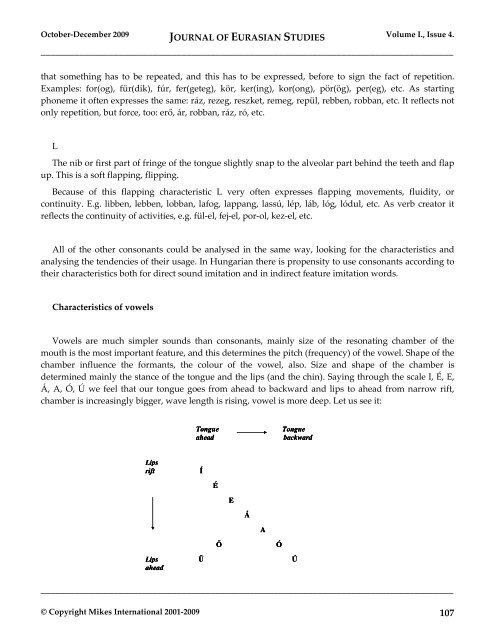JOURNAL OF EURASIAN STUDIES
JOURNAL OF EURASIAN STUDIES
JOURNAL OF EURASIAN STUDIES
You also want an ePaper? Increase the reach of your titles
YUMPU automatically turns print PDFs into web optimized ePapers that Google loves.
October-December 2009 <strong>JOURNAL</strong> <strong>OF</strong> <strong>EURASIAN</strong> <strong>STUDIES</strong> Volume I., Issue 4.<br />
_____________________________________________________________________________________<br />
that something has to be repeated, and this has to be expressed, before to sign the fact of repetition.<br />
Examples: for(og), für(dik), fúr, fer(geteg), kör, ker(ing), kor(ong), pör(ög), per(eg), etc. As starting<br />
phoneme it often expresses the same: ráz, rezeg, reszket, remeg, repül, rebben, robban, etc. It reflects not<br />
only repetition, but force, too: erő, ár, robban, ráz, ró, etc.<br />
L<br />
The nib or first part of fringe of the tongue slightly snap to the alveolar part behind the teeth and flap<br />
up. This is a soft flapping, flipping.<br />
Because of this flapping characteristic L very often expresses flapping movements, fluidity, or<br />
continuity. E.g. libben, lebben, lobban, lafog, lappang, lassú, lép, láb, lóg, lódul, etc. As verb creator it<br />
reflects the continuity of activities, e.g. fül-el, fej-el, por-ol, kez-el, etc.<br />
All of the other consonants could be analysed in the same way, looking for the characteristics and<br />
analysing the tendencies of their usage. In Hungarian there is propensity to use consonants according to<br />
their characteristics both for direct sound imitation and in indirect feature imitation words.<br />
Characteristics of vowels<br />
Vowels are much simpler sounds than consonants, mainly size of the resonating chamber of the<br />
mouth is the most important feature, and this determines the pitch (frequency) of the vowel. Shape of the<br />
chamber influence the formants, the colour of the vowel, also. Size and shape of the chamber is<br />
determined mainly the stance of the tongue and the lips (and the chin). Saying through the scale I, É, E,<br />
Á, A, Ó, Ú we feel that our tongue goes from ahead to backward and lips to ahead from narrow rift,<br />
chamber is increasingly bigger, wave length is rising, vowel is more deep. Let us see it:<br />
Lips<br />
rift Í<br />
Lips<br />
ahead<br />
Tongue<br />
Tongue<br />
ahead<br />
ahead<br />
É<br />
E<br />
Á<br />
Tongue<br />
Tongue<br />
backward<br />
backward<br />
_____________________________________________________________________________________<br />
© Copyright Mikes International 2001-2009 107<br />
A<br />
Ő Ó<br />
Ű Ú
















